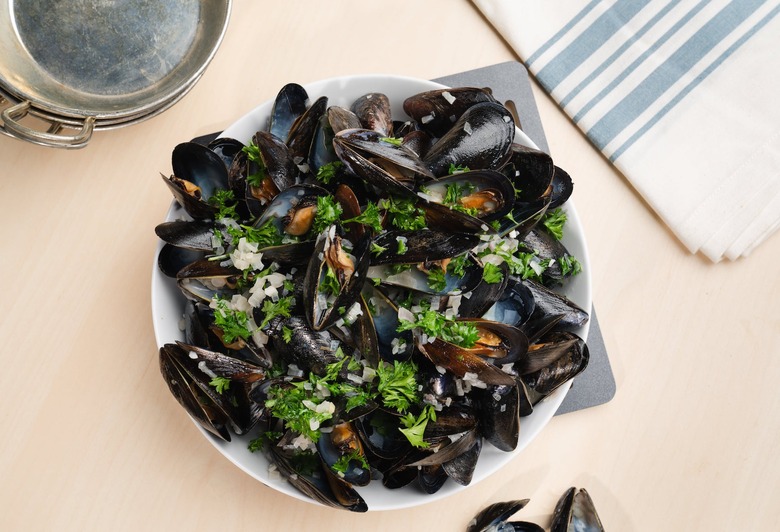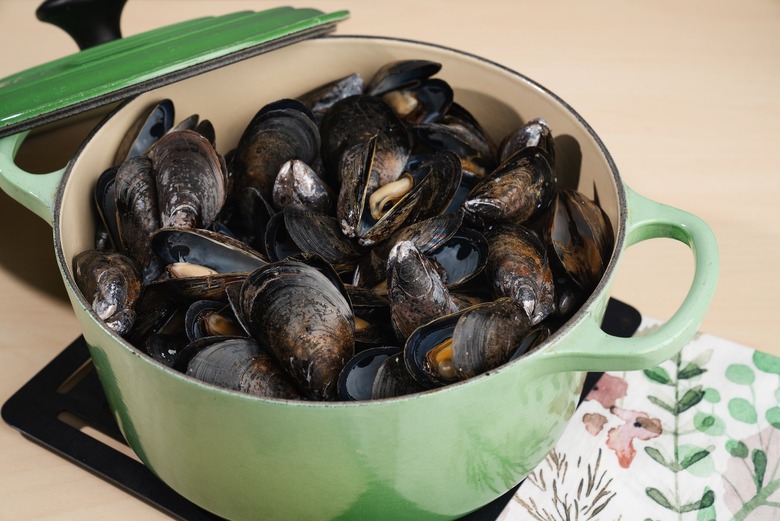Prep School: How To Cook Mussels In 5 Easy Steps
Most people haven't cooked many — if any — mussels in their lifetimes. Just the sight of that little cluster of blue-black shells is sometimes enough to send one scurrying back toward more familiar sea creatures like salmon and shrimp.
Fish Recipes to Satisfy Pescatarians and Meat Eaters Alike
Today, though, we'll embrace the unfamiliar and discuss what to do with mussels, starting when you first lay eyes upon them in the market.
How many mussels to buy per person
Buy enough mussels for the whole gang. Remember to take into account what we in the biz call "yield percentage," which, with mussels, is roughly 25 percent. This means that a pound of mussels will yield about four ounces of meat, a typical serving for one person. So if mussels are your main course, purchase at least one pound per person. If they are an appetizer, a quarter- to a half-pound per person will be just fine.
How to store mussels
Once you get your mussels home, keep them in the fridge. Remove them from their netted bag and keep them in a bowl that's loosely covered by a damp cloth or paper towel. They'll keep like this for a couple of days.
How to tell if your mussels are fresh
Mussels need to be alive when you cook them because their meat begins to deteriorate very quickly. Thus, before cooking, you need to examine your mussels.
First, they should smell fresh, like the ocean. They should certainly not smell fishy. Also, mussels with cracked or broken shells should be tossed, as they're probably dead.
Another telltale sign that your mussel has died is that its shell is open. Now, It's fairly common for mussel shells to be open a little, like they were about to say something but then thought better of it. Here's what you do: Take that mussel and tap it lightly on the counter. If the mussel's still alive, it will close its shell. If it doesn't close, toss it.
How to clean mussels
Before cooking, dump your mussels into a colander in the sink and run cold water over them. Today, most mussels are farm-raised, which means they'll have less mud or seaweed than if they were plucked from their natural habitats. If there is any dirt or mud stuck to the shell, clean it off with a clean sponge or brush.
Next, you need to engage in the process called debearding. The beard or byssus (rhymes with "missus") is the little stringy bundle emanating from the shell. It's made up of protein strands and is what the mussel uses to stay anchored and prevents it from being washed away with the tide. To remove the beard, grasp it with a clean, dry towel and yank it out.
How to cook mussels
You can use dry heat with mussels. Layer them in a dry cast-iron skillet and cook them on the stovetop. You can also balance them individually, if precipitously, on a grill rack over hot coals. You can also roast them in a shallow pan in a hot oven.
The most common way of preparing mussels is steaming. For this, you need a covered pot, a little bit of liquid and a little bit of time — usually five to 10 minutes.
One of the things that makes mussels such a treat is that they hold saltwater in their shells. When steamed, that saltwater turns into a kind of natural mussel broth and mixes with the cooking liquid, delicious and perfect for sopping up with fresh, crunchy bread. You can steam mussels with plain water but you're going to get a more robust tasting final product if you use wine, beer, cider or stock.
Herbs and aromatic vegetables like shallots, garlic, leeks, celery and carrots are often simmered with the liquid for extra flavor. You can also add a little heat with crushed red pepper flakes or fresh chiles like jalapenos or serranos. After the mussels are cooked, the liquid can be enriched with cream or butter.
Here's what you do for a couple of pounds of mussels:
1. If you're using aromatic vegetables, sweat them in a little butter or oil over medium heat in a large, covered pan.
2. When they're limp and translucent, add a cup of liquid and any herbs or spices, increase the heat to very high, and bring it all to a boil.
3. Add the mussels all at once and cover the pan. When the liquid returns to the boil (another minute or so), reduce the heat to medium-low and let the mussels steam until they're nearly all opened.
4. Discard any unopened shells. For family style, simply serve the mussels as-is from the pan or dump the entire contents—liquid and all—into a large bowl. For individual servings, use a slotted spoon to move the mussels to bowls. Quickly whisk an ounce or two of hot cream or softened butter into the liquid. Taste for seasoning, then divide the liquid evenly between the bowls and serve immediately with crusty bread.
5. Accept the appreciative compliments of your assembled diners because now you're in on some of the restaurant secrets every home cook should know.
Mussels Steamed in White Wine
Now that you understand the fundamentals of cooking mussels, it's time to apply that knowledge in the real world. This recipe is as easy yet elegant as they come. Don't forget to serve it with plenty of nice bread.

